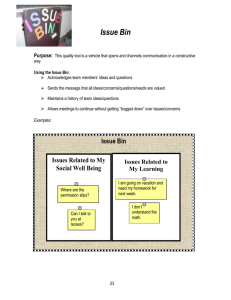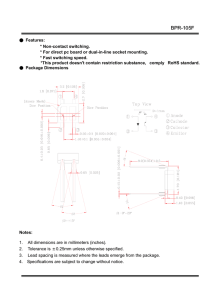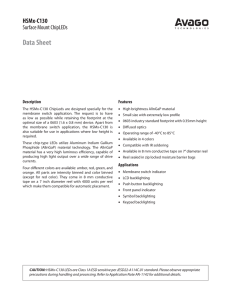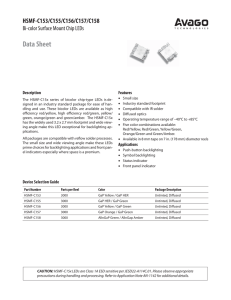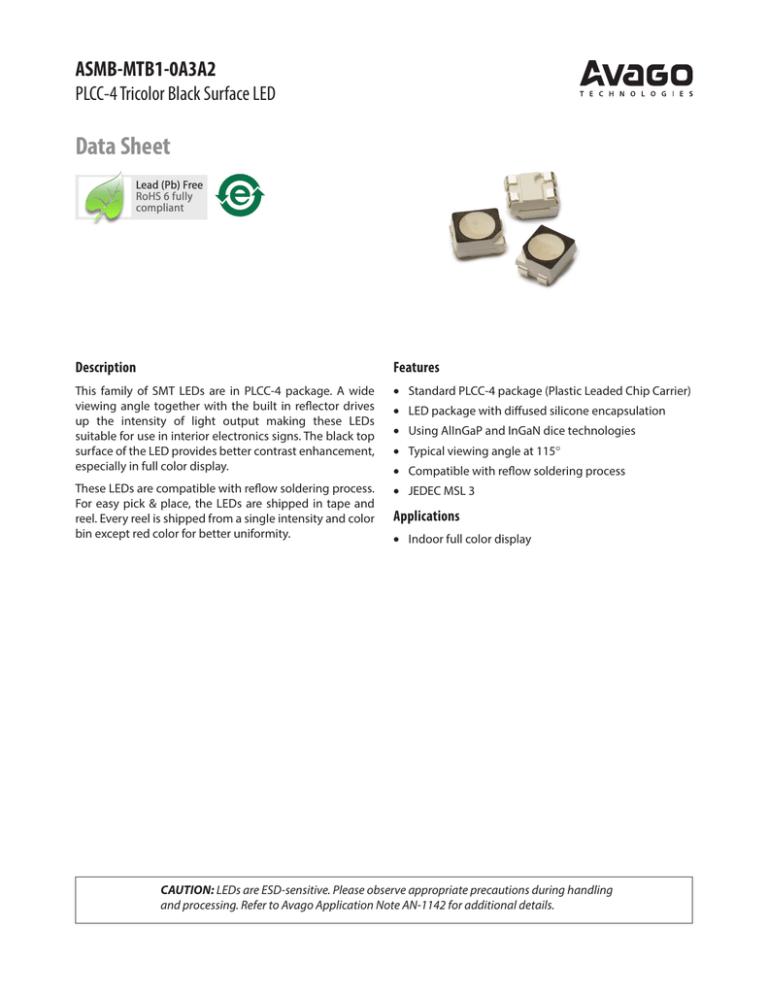
ASMB-MTB1-0A3A2
PLCC-4 Tricolor Black Surface LED
Data Sheet
Description
Features
This family of SMT LEDs are in PLCC-4 package. A wide
viewing angle together with the built in reflector drives
up the intensity of light output making these LEDs
suitable for use in interior electronics signs. The black top
surface of the LED provides better contrast enhancement,
especially in full color display.
• Standard PLCC-4 package (Plastic Leaded Chip Carrier)
These LEDs are compatible with reflow soldering process.
For easy pick & place, the LEDs are shipped in tape and
reel. Every reel is shipped from a single intensity and color
bin except red color for better uniformity.
• JEDEC MSL 3
• LED package with diffused silicone encapsulation
• Using AlInGaP and InGaN dice technologies
• Typical viewing angle at 115°
• Compatible with reflow soldering process
Applications
• Indoor full color display
CAUTION: LEDs are ESD-sensitive. Please observe appropriate precautions during handling
and processing. Refer to Avago Application Note AN-1142 for additional details.
Package Dimensions
1.9
2.8
2
3
2.2
0.8
0.7
0.86
3.5
3.2
∅ 2.4
Package
Marking
1
4
Lead Configuration
1
Cathode (Red)
2
Cathode (Green)
3
Cathode (Blue)
4
Common Anode
0.7
2
3
1
4
Notes:
1. All dimensions are in millimeters (mm).
2. Unless otherwise specified, tolerance = ± 0.20 mm.
3. Encapsulation = silicone
4. Terminal Finish: Silver plating
2
0.8
Table 1. Absolute Maximum Ratings (TJ = 25 °C)
Parameter
Red
Green/Blue
Unit
25
25
mA
100
100
mA
90
mW
DC Forward Current [1]
Peak Forward Current [2]
Power dissipation
65
Reverse Voltage
Not recommended for reverse bias
110
°C
Operating Temperature Range
-40 to 100
°C
Storage Temperature Range
-40 to 100
°C
Junction Temperature
Notes:
1. Derate linearly as shown in Figure 7 to Figure 10.
2. Duty factor = 10% frequency = 1 kHz.
Table 2. Optical Characteristics (TJ = 25 °C)
Luminous Intensity, IV (mcd)
@ IF = 20 mA [1]
Dominant Wavelength, ld (nm)
@ IF = 20 mA [2]
Peak Wavelength, lP (nm)
@ IF = 20 mA
Viewing Angle,
2q½ (°) [3]
Color
Min.
Typ.
Max.
Min.
Typ.
Max.
Typ.
Typ.
Red
450
540
900
619.0
625.0
629.0
634.0
115
Green
1125
1600
2240
525.0
530.0
535.0
522.0
115
Blue
285
350
560
465.0
470.0
473.0
465.0
115
Notes:
1. Luminous intensity, IV is measured at the mechanical axis of the LED package at a single current pulse condition. The actual peak of the spatial
radiation pattern may not be aligned with the axis.
2. Dominant wavelength is derived from the CIE Chromaticity Diagram and represents the perceived color of the device.
3. q1/2 is the off-axis angle where the luminous intensity is ½ of the peak intensity.
Table 3. Electrical Characteristics (TJ = 25 °C)
Color
Forward Voltage, VF (V)
@ IF = 20 mA [1]
Reverse Voltage, VR (V)
@ IR = 100 µA [2]
Reverse Voltage, VR (V)
@ IR = 10 µA [2]
Thermal Resistance,
RqJ-S (°C/W)
Min.
Typ.
Max.
Min.
Min.
Single chip on
Three chips on
Red
1.8
2.1
2.6
4.0
-
609
653
Green
2.8
3.1
3.6
-
4.0
320
430
Blue
2.8
3.1
3.6
-
4.0
320
430
Notes:
1. Tolerance = ± 0.1 V.
2. Indicates product final testing condition. Long-term reverse bias is not recommended.
3
Part Numbering System
A
S
M
B
-
M
T
B
1
-
x1
Code Description
0
A
3
A
2
x2
x3
x4
x5
Option
x1
x2
Package type
Minimum intensity bin
B
A
x3
x4
Number of intensity bins
Color bin combination
3
A
x5
Test option
2
Black surface
Red: bin U1
Green: bin W1
Blue: bin T1
3 intensity bins from minimum
Red: full distribution
Green: bin A, B, D
Blue: bin A, B, C
Test current = 20 mA
Red: bin U1, U2, V1
Green: bin W1, W2, X1
Blue: bin T1, T2, U1
Table 4. Bin Information
Intensity Bins (CAT)
Color Bins (BIN) – Green
Bin ID
Luminous intensity (mcd)
Min.
Max.
T1
285.0
355.0
T2
355.0
450.0
Bin ID
Dominant Wavelength
(nm)
Min.
Max.
Chromaticity Coordinate
(for reference)
Cx
Cy
A
525.0
0.1142
0.8262
0.7178
531.0
U1
450.0
560.0
0.1624
U2
560.0
715.0
0.2001
0.6983
V1
715.0
900.0
0.1625
0.8012
0.1387
0.8148
B
528.0
534.0
V2
900.0
1125.0
W1
1125.0
1400.0
0.1815
0.7089
0.2179
0.6870
0.1854
0.7867
0.1625
0.8012
0.2001
0.6983
0.2238
0.6830
0.1929
0.7816
W2
1400.0
1800.0
X1
1800.0
2240.0
D
Tolerance: ±12%
531.0
535.0
Color Bins (BIN) – Blue
Bin ID
Dominant Wavelength
(nm)
Min.
Max.
Chromaticity coordinate
(for reference)
Cx
Cy
A
465.0
0.1355
0.0399
0.1751
0.0986
0.1680
0.1094
0.1267
0.0534
0.1314
0.0459
0.1718
0.1034
0.1638
0.1167
0.1215
0.0626
B
C
467.0
469.0
Tolerance: ±1 nm
4
469.0
471.0
473.0
0.1267
0.0534
0.1680
0.1094
0.1593
0.1255
0.1158
0.0736
Tolerance: ± 1 nm
Color Bins (BIN) – Red
Bin ID
Dominant Wavelength
(nm)
Min.
Max.
Chromaticity Coordinate
(for reference)
Cx
Cy
--
619.0
0.6894
0.3104
0.6752
0.3113
0.6916
0.2950
0.7066
0.2934
Tolerance: ±1 nm
629.0
Characteristics
100
1.0
Green
FORWARD CURRENT (mA)
Blue
0.6
0.4
0.2
450
500
550
600
WAVELENGTH (nm)
650
Figure 1. Relative Intensity vs. Wavelength
1.6
NORMALIZED INTENSITY
1.2
1.0
0.8
0.6
0.4
0.2
0.0
0
5
10
15
FORWARD CURRENT (mA)
20
25
Figure 3. Relative Luminous Intensity vs. Forward Current
NORMALZIED INTENSITY
10
60
40
20
0
0
1
2
3
FORWARD VOLTAGE (V)
4
5
Figure 2. Forward Current vs. Forward Voltage
Red
Green
Blue
1.4
RED
GREEN/BLUE
80
700
RELATIVE DOMINANT WAVELENGTH SHIFT (nm)
0.0
400
7
Red
Green
Blue
6
5
4
3
2
1
0
-1
-2
0
5
10
15
FORWARD CURRENT (mA)
20
25
Figure 4. Dominant Wavelength Shift vs. Forward Current
RED
GREEN
BLUE
1
0.5
FORWARD VOLTAGE SHIFT (V)
NORMALIZED INTENSITY
0.8
Red
RED
GREEN
BLUE
0.4
0.3
0.2
0.1
0
-0.1
-0.2
0.1
-40
-20
0
20
40
60
80
TJ -JUNCTION TEMPERATURE (°C)
Figure 5. Relative Luminous Flux vs. Junction Temperature
5
100
120
-0.3
-40
-20
0
20
40
60
80
TJ -JUNCTION TEMPERATURE (°C)
Figure 6. Forward Voltage Shift vs. Junction Temperature
100
120
30
MAXIMUM FORWARD CURRENT (mA)
MAXIMUM FORWARD CURRENT (mA)
30
TS
20
TA
10
0
0
20
40
60
80
TEMPERATURE (°C)
100
10
0
20
40
60
80
TEMPERATURE (°C)
TS
20
TA
10
0
20
40
60
TEMPERATURE (°C)
80
100
Figure 9. Maximum Forward Current vs. Temperature for Green & Blue
(1 Chip On)
120
TS
20
TA
10
0
0
20
40
60
TEMPERATURE (°C)
Condition
Thermal resistance from LED junction to ambient, RθJ-A (°C/W)
Red
Green & Blue
1 chip on
725
454
3 chips on
970
747
80
100
Figure 10. Maximum Forward Current vs. Temperature for Green & Blue
(3 Chips On)
Note:
Maximum forward current graphs based on ambient temperature, TA are with reference to thermal resistance RθJ-A (see below).
For more details, see Precautionary Notes, item 4.
6
100
30
MAXIMUM FORWARD CURRENT (mA)
MAXIMUM FORWARD CURRENT (mA)
TA
Figure 8. Maximum Forward Current vs. Temperature For Red (3 Chips On)
30
0
20
0
120
Figure 7. Maximum Forward Current vs. Temperature For Red (1 Chip On)
TS
1.0
0.80
0.8
0.60
NORMALIZED INTENSITY
NORMALIZED INTENSITY
1.00
RED
GREEN
BLUE
0.40
0.20
0.00
-90
-60
-30
0
30
ANGULAR DISPLACEMENT (DEGREE)
Figure 11a. Radiation pattern along x-axis of the package
Figure 11c. Illustration of package axis for radiation pattern
7
60
90
0.6
0.4
RED
GREEN
BLUE
0.2
0.0
-90
-60
-30
0
30
ANGULAR DISPLACEMENT (DEGREE)
Figure 11b. Radiation pattern along y-axis of the package
60
90
2.6
1.1
4.5
1.5
Copper pad
Solder mask
Maximize the size of copper pad of PIN 4
for better heat dissipation.
2 ± 0.05
3.81 ± 0.1
3.50 ± 0.05
4 ± 0.1
3.05 ± 0.1
Figure 13. Carrier Tape Dimension
8
+0.2
∅1.0 0
PACKAGE MARKING
USER FEED DIRECTION
2.14 ± 0.1
+0.3
8.0 +0.1
4 ± 0.1
+0.1
∅1.5 0
1.75 ± 0.1
Figure 12. Recommended soldering land pattern
0.23 ± 0.05
USER FEED DIRECTION
PACKAGE MARKING
PRINTED LABEL
Figure 14. Reel Orientation
8.0 ± 1.0 (0.315 ± 0.039)
10.50 ± 1.0 (0.413 ± 0.039)
13.1 ± 0.5
Ø (0.516 ± 0.020)
20.20 MIN.
Ø (0.795 MIN.)
3.0 ± 0.5
(0.118 ± 0.020)
59.60 ± 1.00
(2.346 ± 0.039)
178.40 ± 1.00
(7.024 ± 0.039)
4.0 ± 0.5
(0.157 ± 0.020)
Figure 15. Reel Dimension
9
6
PS
5.0 ± 0.5
(0.197 ± 0.020)
Packing Label
(i) Standard label (attached on moisture barrier bag)
(1P) Item: Part Number
STANDARD LABEL LS0002
RoHS Compliant Halogen Free
e4 Max Temp 260C MSL3
(1T) Lot: Lot Number
(Q) QTY: Quantity
LPN:
CAT: Intensity Bin
(9D)MFG Date: Manufacturing Date
BIN: Color Bin
(P) Customer Item:
(9D) Date Code: Date Code
(V) Vendor ID:
DeptID:
Made In: Country of Origin
(ii) Baby label (attached on plastic reel)
(1P) PART #: Part Number
BABY LABEL COSB001B V0.0
(1T) LOT #: Lot Number
(9D)MFG DATE: Manufacturing Date
QUANTITY: Packing Quantity
C/O: Country of Origin
(9D): DATE CODE:
(1T) TAPE DATE:
D/C: Date
Code
CAT:
U1 W1 VF:
T1
CAT: INTENSITY BIN
BIN: COLOR BIN
Intensity for Blue: T1
Intensity for Green: W1
Example of luminous intensity (Iv) bin information on
label:
CAT: U1 W1 T1
Intensity for Red: U1
Example of color bin information on label:
BIN: A B
Intensity for Blue: T1
Intensity for Green: W1
Intensity for Red: U1
BIN: A B
10
Color Bin for Blue: B
Color Bin for Blue: B
Color Bin for Green: A
Note:
There is no color bin ID for Red as there is only one range, as stated in
Table 4.
Soldering
Recommended reflow soldering condition:
(i) Leaded reflow soldering:
(ii) Lead-free reflow soldering:
20 SEC. MAX.
183°C
100-150°C
-6°C/SEC.
MAX.
3°C/SEC.
MAX.
120 SEC. MAX.
60-150 SEC.
TIME
a.Reflow soldering must not be done more than two
times. Make sure you take the necessary precautions
for handling a moisture-sensitive device, as stated in
the following section.
b. Recommended board reflow direction:
TEMPERATURE
TEMPERATURE
10 to 30 SEC.
240°C MAX.
3°C/SEC. MAX.
217°C
200°C
255 - 260 °C
3°C/SEC. MAX.
6°C/SEC. MAX.
150°C
3 °C/SEC. MAX.
100 SEC. MAX.
60 - 120 SEC.
TIME
c. Do not apply any pressure or force on the LED during
reflow and after reflow when the LED is still hot.
d.It is preferred that you use reflow soldering to
solder the LED. Use hand soldering only for rework
if unavoidable but must be strictly controlled to the
following conditions:
- Soldering iron tip temperature = 320 °C max.
- Soldering duration = 3 sec max.
- Number of cycles = 1 only
- Power of soldering iron = 50 W max.
e. Do not touch the LED body with a hot soldering iron
except the soldering terminals as this may damage the
LED.
f. For de-soldering, it is recommended that you use a
double flat tip.
g. Please confirm beforehand whether the functionality
and performance of the LED is affected by hand
soldering.
REFLOW DIRECTION
11
PRECAUTIONARY NOTES
1. Handling precautions
The encapsulation material of the LED is made of silicone for better product reliability. Compared to epoxy
encapsulant, which is hard and brittle, silicone is softer
and flexible. Observe special handling precautions during assembly of silicone-encapsulated LED products.
Failure to comply might lead to damage and premature failure of the LED. For more information, refer to
Application Note AN5288, Silicone Encapsulation for
LED: Advantages and Handling Precautions.
a.Do not poke sharp objects into the silicone
encapsulant. Sharp objects such as tweezers and
syringes might cause excessive force to be applied
or even pierce through the silicone, inducing failures
in the LED die or wire bond.
b. Do not touch the silicone encapsulant. Uncontrolled
force acting on the silicone encapsulant might result
in excessive stress on the wire bond. The LED should
be held only by the body.
c.Do no stack assembled PCBs together. Use an
appropriate rack to hold the PCBs.
d. The surface of silicone material attracts more dust
and dirt compared to epoxy due to its surface
tackiness. To remove foreign particles on the surface
of silicone, a cotton bud can be used with isopropyl
alcohol (IPA). During cleaning, rub the surface gently
without applying excessive pressure on the silicone.
Ultrasonic cleaning is not recommended.
e.For automated pick and place, Avago has tested
the following nozzle size to work fine with this
LED. However, due to possible variations in other
parameters such as pick and place machine
maker/model and other settings of the machine,
it is recommended that you verify that the nozzle
selected will not damage the LED.
2. Handling of moisture-sensitive device
This product has a Moisture Sensitive Level 3 rating
per JEDEC J-STD-020. Refer to Avago Application Note
AN5305, Handling of Moisture Sensitive Surface Mount
Devices, for additional details and a review of proper
handling procedures.
a. Before use
- An unopened moisture barrier bag (MBB) can be stored
at < 40 °C/90% RH for 12 months. If the actual shelf life
has exceeded 12 months and the Humidity Indicator Card
(HIC) indicates that baking is not required, then it is safe to
reflow the LEDs per the original MSL rating.
- It is recommended that the MBB not be opened before
assembly (e.g., for IQC).
b. Control after opening the MBB
- Read the HIC immediately upon opening the MBB.
- The LEDs must be kept at < 30 °C/60% RH at all
times and all high temperature related processes
including soldering, curing or rework must be
completed within 168 hours.
c. Control for unfinished reel
- Unused LEDs must be stored in a sealed MBB with
desiccant or desiccator at < 5% RH.
d. Control of assembled boards
- If the PCB soldered with the LEDs is to be subjected
to other high temperature processes, then the PCB
must be stored in a sealed MBB with desiccant or
desiccator at < 5% RH to ensure that all LEDs have
not exceeded their floor life of 168 hours.
e. Baking is required if:
- The HIC indicator is not BROWN at 10% and is AZURE
at 5%.
- The LEDs are exposed to a condition of > 30 °C/60%
RH at any time.
- The LED floor life exceeded 168 hours.
The recommended baking condition is: 60 ± 5 °C for
20 hours.
Baking should be done only once.
f.Storage
ID
OD
ID = 1.7 mm
OD = 3.5 mm
12
- The soldering terminals of these Avago LEDs are
silver-plated. If the LEDs are exposed in ambient
environment for too long, the silver plating
might be oxidized and thus affect its solderability
performance. As such, unused LEDs must be kept in
a sealed MBB with desiccant or in desiccator at < 5%
RH.
3. Application precautions
a.Drive current of the LED must not exceed the
maximum allowable limit across temperature as
stated in the datasheet. Constant current driving is
recommended to ensure consistent performance.
The complication of using this formula lies in TA and
RqJ-A. Actual TA is sometimes subjective and hard to determine. RqJ-A varies from system to system depending
on design and is usually not known.
b.The LED is not intended for reverse bias. Do use
other appropriate components for such a purpose.
When driving the LED in matrix form, make sure the
reverse bias voltage does not exceed the allowable
limit for the LED.
Another way of calculating TJ is by using solder point
temperature TS as shown as follows:
c. Do not use the LED in the vicinity of material with
sulfur content, in an environment of high gaseous
sulfur compound and corrosive elements. Examples
of materials that may contain sulfur are rubber
gasket, Room Temperature Vulcanizing (RTV)
silicone rubber, rubber gloves, and so on. Prolonged
exposure to such an environment may affect the
optical characteristics and product life.
TJ = TS + RqJ-S × IF × VFmax
where
TS = LED solder point temperature as shown in the following illustration [°C]
RqJ-S = thermal resistance from junction to solder point
[°C/W]
d.Avoid a rapid change in ambient temperature
especially in a high humidity environment as this
will cause condensation on the LED.
4. Thermal management
Optical, electrical and reliability characteristics of LED
are affected by temperature. The junction temperature
(TJ ) of the LED must be kept below the allowable limit
at all times. TJ can be calculated as follows:
TJ = TA + RqJ-A × IF × VFmax
where
TA = ambient temperature [°C]
RqJ-A = thermal resistance from LED junction to ambient [°C/W]
IF = forward current [A]
Ts point
(PIN 4)
TS can be easily measured by having a thermocouple
mounted on the soldering joint, as shown in this illustration, while RqJ-S is provided in the datasheet. Please
verify the TS of the LED in the final product to ensure
that the LEDs are operated within all maximum ratings
stated in the datasheet.
5. Eye safety precautions
LEDs may pose optical hazards when in operation. It is
not advisable to view directly at operating LEDs as it
may be harmful to the eyes. For safety reasons, use appropriate shielding or personal protective equipment.
VFmax = maximum forward voltage [V]
DISCLAIMER: Avago’s products and software are not specifically designed, manufactured or authorized for sale
as parts, components or assemblies for the planning, construction, maintenenace or direct operation of a
nuclear facility or for use in medical devices or applications. Customer is solely responsible, and waives all rights to
make claims against Avago or its suppliers, for all loss, damage, expense or liability in connection with such use.
For product information and a complete list of distributors, please go to our web site:
www.avagotech.com
Avago, Avago Technologies, and the A logo are trademarks of Avago Technologies in the United States and other countries.
Data subject to change. Copyright © 2005-2015 Avago Technologies. All rights reserved.
AV02-4194EN - May 22, 2015

